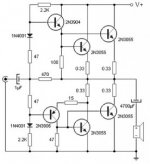


The complementary transistors are both connected in the common collector configuration (emitter followers) so they have essentially unity voltage gain.Ĭoupled to the BC286 is the 2N3055 in a Darlington configuration. If the bases of these two transistors were tied together, it would be a zero bias class B, but the bias regulator develops just enough voltage to put the complementary transistors just on the edge of conduction.

The BC107 is the bias regulator that develops approx 3 junction drops (1.95V) to properly drive the complementary transistors (top BC286 and the BC287). C1 and the resistor above it also provide frequency comp by reducing the AC feed back to the input stage. It is the high voltage gain element and requires a frequency compensation cap (C2) to prevent oscillation. The top left capacitor and resistor are noise decoupling for the bias source for the input transistor to keep it from amplifying the power supply noise and ripple.Ī signal is picked off the collector resistor to drive the base of the lower BD286. With feedback as such, it has essentially unity AC and DC gain. It also regulates the DC operating point of the output bus. The PNP input stage is configured as a common emitter amplifier with lots of current feedback through the emitter resistor that is tied to the output bus.


 0 kommentar(er)
0 kommentar(er)
